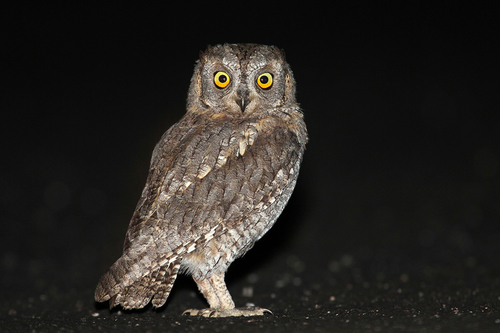
Eurasian Scops Owl
The Eurasian Scops Owl (*Otus scops*) is a small, nocturnal owl known for its distinctive, monotonous call, often heard on warm summer nights across its extensive range. This species plays a crucial role in controlling insect populations, particularly large beetles and moths. It is a highly migratory owl, undertaking long journeys between its breeding grounds in Europe and Asia and its wintering grounds in sub-Saharan Africa. While not globally threatened, it faces localized declines due to habitat loss and pesticide use. In some cultures, its call is considered a harbinger of good luck or a warning, reflecting its close association with human settlements and agricultural landscapes.
19-21 cm
Length
47-54 cm
Wingspan
Least Concern
Conservation Status
Distribution
The Eurasian Scops Owl breeds across southern Europe, parts of central and western Asia, and North Africa. It is a long-distance migrant, wintering primarily in sub-Saharan Africa, south of the Sahara Desert and north of the rainforest belt. Its altitudinal range varies, from sea level to mountainous regions up to 2,000 meters in some areas.
Lifespan
Up to 6 years in the wild; longer in captivity.
Eurasian Scops Owl's Habitat
Habitat Types
Open woodlands, Parks and gardens, Orchards, Olive groves, Savannas with scattered trees
Climate Zones
Temperate, Mediterranean, Subtropical
Adaptations
Their cryptic plumage provides excellent camouflage against tree bark, allowing them to roost inconspicuously during the day. Their relatively small size allows them to maneuver easily through dense vegetation while hunting.
Variations
Several subspecies are recognized, differing slightly in plumage coloration and size, reflecting adaptations to local environments across its broad range. For example, *Otus scops cycladum* is found on the Cyclades Islands.
Appearance
Breeding Plumage
Plumage is generally similar year-round, but fresh plumage after molting may appear brighter.
Seasonal Feather Changes
Limited seasonal variation; primarily differences in wear and tear.
Sex Based Plumage Differences
Very subtle; females may have slightly more distinct markings in some populations.
Notable Features
Small ear tufts (often held flat and inconspicuous), Gray-brown or rufous-brown cryptic plumage with intricate patterns, Yellow eyes, Relatively small size compared to other European owls
Diet and Feeding
Primary Foods
Large insects (beetles, moths, crickets), Spiders, Small vertebrates (occasionally mice, small birds, lizards)
Foraging Behavior
Primarily hunts from a perch, swooping down to capture prey on the ground or in vegetation. Also catches insects in flight. Most active at dusk and during the night.
Specializations
Excellent night vision and hearing adapted for locating prey in low-light conditions. Sharp talons for grasping prey.
Seasonal Diet Variations
Diet may shift slightly depending on prey availability; for example, more small vertebrates may be taken during the breeding season to feed young.
Behavior
Social Structure
Generally solitary or in pairs during the breeding season. May form small, loose flocks during migration.
Communication
Monotonous 'tyu' call (male's territorial and courtship call), Various hisses and clicks used in close-range interactions, Bill-snapping as a threat display
Migration
A long-distance migrant, traveling at night. Migratory routes are not fully understood but generally follow a north-south direction between Europe/Asia and Africa. Migration is triggered by decreasing day length and food availability.
Territorial or Group Behaviors
Males defend territories during the breeding season through vocalizations and occasional chases. Territories are relatively small, often centered around a suitable nesting cavity.
Conservation
Threats
Habitat loss (deforestation, agricultural intensification), Pesticide use (reducing insect prey), Collisions with vehicles, Climate change (potentially affecting migration timing and prey availability)
Protection Programs
Listed on Appendix II of CITES (Convention on International Trade in Endangered Species), Protected under various national and international bird protection laws (e.g., EU Birds Directive)
Local National Laws
Protected in most European countries; specific regulations vary.
Population Trend
Decreasing in some parts of its range, but overall considered stable.
Population Estimates
Global population estimated to be 195,000-408,000 mature individuals.
Interesting Facts
They can rotate their heads up to 270 degrees.
This allows them to scan a wide area for prey without moving their bodies, enhancing their stealth.
They are one of the smallest owl species in Europe.
Their small size allows them to exploit a niche of hunting smaller prey than larger owl species.
Their call is often mistaken for that of a frog or toad.
The monotonous, single-note call is quite different from the typical hooting of many other owl species.
The Eurasian Scops Owl is a nocturnal bird.
It is most active during the night.
Faqs about Eurasian Scops Owl
What do I do if I find an injured Eurasian Scops Owl?
Contact a local wildlife rehabilitation center or veterinarian specializing in birds. Do not attempt to care for it yourself without expert guidance. *Consult a professional for expert advice.*
Are Eurasian Scops Owls dangerous to humans?
No, they are small and pose no threat to humans. They are generally shy and avoid human contact.
How can I attract Eurasian Scops Owls to my garden?
Providing suitable nesting sites (e.g., nest boxes) and maintaining a pesticide-free environment with plenty of trees and shrubs can help attract them.
What is the lifespan of Eurasian Scops Owls?
The lifespan is up to 6 years in the wild.
Copyright @ Nature Style Limited. All Rights Reserved.
 English
English